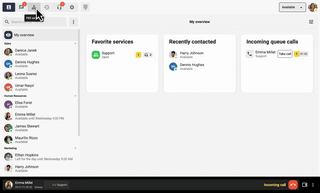Updating your phone policy is essential if, for example, you’ve got a brand new telephony system, moved to a cloud PBX or bought a bunch of new phones. And no – it’s not enough to just send out an internal informative email. Here are our top tips on how to create a first-class phone policy.
A telephone policy improves quality and results
With a telephone policy in place, you will improve the quality of your customer service faster than lightning. A common approach creates a clear image of your company – where all calls are treated equally, whether they call support, customer service or an individual salesperson, for example.
A telephone policy doesn’t have to be formal and rigid either, it’s more important that it reflects your company culture in a good way, so that all employees can take it to heart and understand how you as an individual are important for the whole company to work.
A telephone policy can also help you to actually increase the results of your business in the long run. Because today, few people will continue to seek out a business that doesn’t respond to voicemail messages, or where customer service has been rude on the phone. Customers get annoyed when no one calls them back even though they left a message – or if they don’t know where they are – which is the risk if you don’t have a strategy in place. So a telephone policy will ultimately help you connect with more potential customers.
Who is responsible for your telephone policy?
In many companies, it’s often a bit tricky who owns the issue of your telephone policy. The IT department may decide what telephony solutions you should have, but is it reasonable that they should also be responsible for communication to the rest of the employees? No, exactly. Since telephony is part of your public face – just like your other marketing – the policy should be in the hands of someone who has overall marketing responsibility for the company (e.g. a marketing manager). A telephone policy is basically aimed at constantly creating more satisfied customers and employees. By making it clear who is responsible for it, you also raise the importance of your telephone policy to the entire organization.
What is private and what is work?
It was a while ago that every employee had a fixed phone on their desk that was sacred in communication with customers and partners. Today, everyone has a mobile phone in their pocket that they use around the clock in several different contexts – which makes it extra important to control what should be private and what is work-related. Many companies spend large sums of money on expensive phones and powerful systems with many possibilities – then it is necessary that these are used correctly in the organization!
Start from the statistics and optimize accordingly
With modern tools and systems, it is easy to get statistics on how your company works – what you do well today, and what you have to work on. This is a good foundation on which to base a telephone policy. You can see exactly how many customers have called you, how many hung up before you answered, what your response times are, and how many have been helped with their query. In some cases, it starts with a gut feeling – customers might say they’re having trouble reaching you, or you might notice that your customer service team isn’t resolving as many cases as they should. Investing in a platform that shows these numbers in black and white in the first place will often lead to the realization that you need to create or update procedures to optimize your business.
How to update your phone policy – step by step
1. ask yourself the following questions:
- What is a relevant level of reachability in our business? People wait a minute max – then hang up. Decide how accessible you should be, what is a reasonable time for feedback and how you can make it easier for customers to get in touch with you.
- If we have a long phone queue, what other channels can you use to reach us? You might recommend chat, posting on social media or even visiting the office.
- What do customers say about us? The bigger your company gets, the worse your phone culture gets, and your customers’ opinions play a big role in how you manage your business.
- What is our current situation? If you have existing policies that are not working, if you have grown rapidly, changed systems or similar – find out what your starting points are internally so it is easier to focus on the right things.
- What do our statistics say – what figures do we have to go on? If your system has been collecting data for a longer period of time, it will be easy to determine which areas you might want to focus on.
- How does it work in different departments? Some teams may perform worse or better than others. Find out why and you can regulate it specifically in the policy.
2. use a telephone policy template as a basis
Whether you already have an existing policy or need to create one from scratch, it can be helpful to have a concrete and clear template to work from – so you know you’ve covered all the necessary elements. Even if you think you have a good idea of what your employees need to know and work to, it’s easy to forget some things. With a template as a starting point, you can then add details that are specific to your company.
Short on time? Make it easy on yourself and download our phone policy template here!
3. Be personal
Make sure your phone policy reflects your company culture. Encourage personalized greetings that play with your tone and overall communication, and provide advice and suggestions so that each employee can adopt the policy in a way that suits them.
4. Implementing the policy in your business
Just as it is important that there is an owner of the policy, it is necessary that it is implemented correctly in the business. It can be tiring and annoying to have yet another policy document to follow – but if you do it right from the start, it will become a natural part of every employee’s everyday life.
- For new employees: Make sure that all new employees who are given a phone also receive the policy at the same time. And require them to read (and understand) it before they start work!
- For existing employees: Organize a breakfast seminar or information session where you highlight statistics and the need for the policy. Tip! Don’t be afraid to use both a little carrot and a stick. With the statistics in your system, you can see exactly how your employees are performing – so why not set a target that you can celebrate when it is achieved?
5. monitoring and evaluation
By conducting a baseline analysis before you start working with your phone policy and a report afterwards, you will gain clear insights into how it has impacted your employees – and your customers. Give it three months and then evaluate. And don’t forget to toast if it went well!
A telephone policy is a good start on the road to a clearer image of your company, better customer service and improved performance. Telavox delivers telephony and switchboard services in a smart platform that is available on all devices and platforms. If you want to strengthen both your internal and external communication, get in touch and we’ll talk further!

